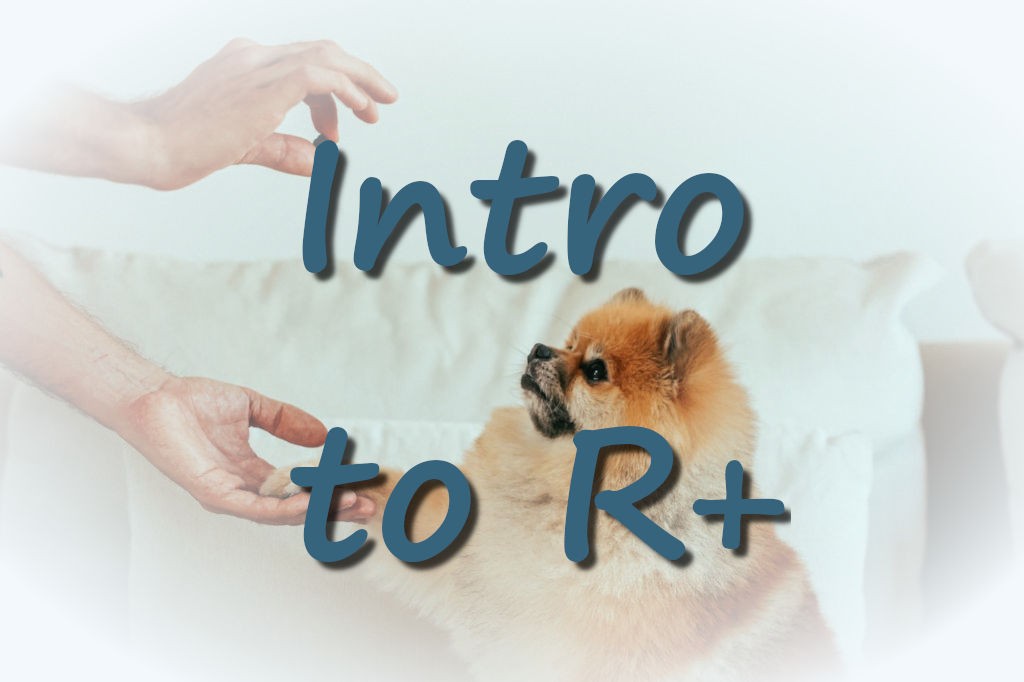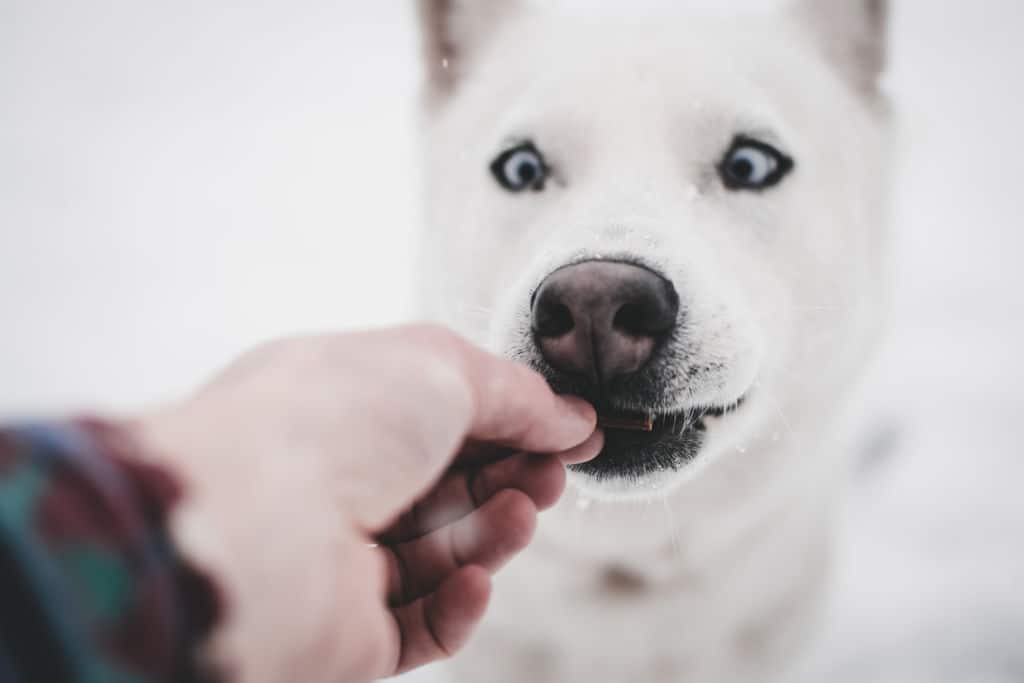Are you interested in understanding how to effectively train your dog while building a stronger bond with them? Positive reinforcement may be the answer you’re looking for.
This widely used training method involves rewarding desired behaviors to encourage their repetition. This post will delve into the world of positive reinforcement, exploring its principles and the impact it can have on your dog’s behavior and your relationship with them.
From the science behind it to its benefits, we will provide a comprehensive overview of positive reinforcement and why it is a valuable tool for dog training. So, get ready to unlock the power of positive reinforcement and take your training to the next level!

What is Positive Reinforcement?
Positive reinforcement (R+) is a powerful training tool that involves rewarding desired behaviors to encourage their repetition.
For instance, let’s say your dog has a habit of digging up your garden. Instead of scolding them after they’ve done it, try giving them a toy or treat when they play instead of dig, steering their interest away from your plants.
It creates a positive association between the behavior and the reward, making the behavior more likely to occur again in the future. This method is effective because it is non-threatening, humane, and builds trust and a strong bond between the dog and its owner.
Positive, Negative, Reinforcement, Punishment – Defined
Since there are positive and negative versions of reinforcement (as well as punishment), let’s define a few terms:
- Positive reinforcement (R+): giving something positive to reinforce a behavior. Example: Giving your dog a treat after they sit on command.
- Negative reinforcement (R-): removing something bad to reinforce a behavior. Example: Taking away the pressure of a choke collar when your dog stops pulling on the leash.
- Positive punishment (P+): adding something unpleasant to punish a behavior. Example: Saying “No!” and tapping your dog’s nose when they jump on visitors.
- Negative punishment (P-): taking away something positive to punish a behavior. Example: Taking away your dog’s toy as a consequence for biting.
Compared to positive punishment, positive reinforcement is less confrontational and less likely to cause fear or anxiety.
Research supports using mostly non-aversive techniques, primarily positive reinforcement, and occasional negative punishment. However, P- can also be less humane than positive reinforcement, as it involves taking away something positive as punishment, which can cause fear or anxiety in some dogs.
A combination of positive reinforcement and other training methods can be effective, with most trainers primarily using R+ and minimal P-.
Remember that dogs, like humans, react more responsively to incentives than deterrents. Just as a child might be more likely to complete their homework with the promise of a treat, a dog might be quicker to obey with the lure of their favorite chew toy.
How does Positive reinforcement work?
Positive reinforcement uses the principle of operant conditioning to modify behavior. This training method is based on the idea that behavior can be strengthened by reinforcing desired actions with positive consequences.
When a dog performs a desired behavior, it is immediately followed by a reward, such as a treat, praise, or a toy. This creates a positive association between the behavior and the reward, making the behavior more likely to occur in the future.
This process of shaping behavior through positive reinforcement is a powerful and effective tool for dog training and building a stronger bond with your pet.
The science behind operant conditioning
Operant conditioning is a type of learning that explains how consequences shape our behavior.
It is based on the idea that behaviors that are followed by positive outcomes are more likely to be repeated, while those followed by negative ones tend to decrease in repetition.
Here’s a straightforward way to look at it: Imagine you got a bonus at work every time you turned in a project early; you’d likely start handing in all your tasks ahead of time. Similarly, when a dog realizes that sitting quietly leads to a tasty treat, they’ll be more likely to adopt that behavior.
By providing positive consequences, such as treats or praise, trainers can humanely and effectively influence their pet’s behavior.

The role of rewards in shaping behavior
Rewards play a key role in positive reinforcement training. By providing something positive after a desired behavior, you are strengthening the behavior and making it more likely to occur again in the future.
The key to effective positive reinforcement is choosing a reward that your dog values, which motivates him to repeat the desired behavior. This could be a high-value treat, toy, praise, or attention.
Experimenting with different rewards can help you find what works best for your dog and ensure that positive reinforcement is an effective tool for shaping desired behaviors.
Keep a pocketful of treats on hand during walks. Whenever your dog behaves well around distractions like other animals or noisy traffic, reward them immediately. Over time, they’ll associate those challenging situations with good behavior.
Positive Reinforcement vs. Punishment-Based Training
Positive reinforcement uses positive consequences (treats/praise) to increase desired behaviors, while punishment-based training uses negative consequences (scolding/corrections) to decrease undesired behaviors.
The R+ method is a more humane, effective, and enjoyable way to train your dog. It strengthens desired behaviors, builds trust and a strong bond between the dog and its owner, and improves motivation and engagement in training.
On the other hand, punishment-based training can be confrontational, threatening, and damage the relationship between the dog and its owner. Scientific studies also suggest that aversive methods are often less effective and can lead to dogs having poorer welfare.
Advantages of Positive Reinforcement for Dogs
1. Improves behavior and obedience
Positive reinforcement training focuses on rewarding desired behaviors, which encourages the dog to repeat these behaviors in the future. This results in improved obedience and a reduction in undesirable behaviors.
In fact, dogs that are trained using positive reinforcement tend to adapt better to new situations. Think of it this way: If you’re moving to a new place or introducing a new family member, a dog accustomed to rewards will look for ways to earn those incentives, making the transition smoother for everyone involved.
2. Builds trust and strengthens bonds
By consistently rewarding good behavior, the dog begins to associate positive experiences with the owner. This builds trust and strengthens the bond between the owner and dog, creating a more harmonious relationship.
3. Reduces stress and anxiety in dogs
Positive reinforcement training is a non-threatening and humane method of training. It does not involve physical or emotional harm, which can reduce stress and anxiety in dogs. Additionally, positive reinforcement training can increase a dog’s confidence and motivation, further reducing stress and anxiety.
Comparing Positive and Negative Reinforcement
Positive reinforcement (R+) and negative reinforcement (R-) are two sides of the same coin. While positive reinforcement involves adding a positive consequence to reinforce a behavior, negative reinforcement involves removing a negative consequence to reinforce a behavior.
For example, if your dog sits when asked, you can reinforce the behavior with a treat (positive reinforcement) or remove a treat if they don’t sit (negative reinforcement).
Explanation of negative reinforcement
Negative reinforcement is a type of operant conditioning that involves removing an aversive stimulus to increase the likelihood of a desired behavior being repeated.
In other words, negative reinforcement strengthens a behavior by removing something unpleasant or uncomfortable that the dog wants to avoid.
An example of negative reinforcement is when a dog jumps on the couch, and you remove the cushion to make the surface uncomfortable, so the dog will stop jumping on the couch. Removing the uncomfortable cushion reinforces the dog’s behavior of not jumping on the couch.

Advantages of Positive Reinforcement Over Negative
Positive reinforcement is superior to negative reinforcement in several ways:
- Positive reinforcement is a more humane and effective training method, strengthening desired behaviors and improving the bond between the dog and the owner.
- It does not cause fear or anxiety in dogs, as it does not involve physical or emotional harm.
- Negative reinforcement can be confusing for dogs as it involves removing a consequence that may or may not be related to the desired behavior.
- Negative reinforcement can create fear or anxiety in dogs as they may start associating certain activities with removing a negative consequence.
- Over time, the use of negative reinforcement may cause the dog to become more resistant to training and lead to worsened behavior, as the dog associates punishment with the person, not the action.
- Positive reinforcement reinforces good behavior with rewards or redirects negative behavior with positive behavior and rewards, strengthening the desired behavior.
A Balanced Approach to Dog Training May Be Ideal
While most registered trainers advocate for positive-only training methods, it’s unrealistic to expect 100% positive reinforcement.
A balanced approach involves thoughtfully and ethically combining techniques, as different methods may be more effective for different dogs and training goals.
Most trainers balance their approach, primarily using positive reinforcement (R+) and minimal negative punishment (P-). Some trainers choose not to use corrections at all (R- and P+).
For example, a balanced approach might involve using positive reinforcement to encourage good behavior, negative punishment to discourage behaviors like jumping up on people by removing attention or treats, and using positive punishment in a rare and controlled manner, such as a firm “no” or a time-out, to address particularly problematic behaviors.
While positive reinforcement is favored for its humane and effective nature, it isn’t the only technique used in dog training. Techniques like negative reinforcement and positive punishment may be used when necessary, but always ethically and humanely.
Summary of benefits for R+
Here is the summary of Benefits of Positive Reinforcement for dogs:
- Improves behavior and obedience
- Improves relationship between dog and owner
- Non-threatening and humane training method
- Increases a dog’s confidence
- Reduces stress and anxiety in dogs
- Reinforces desired behaviors
- Increases confidence and motivation
- Effective and enjoyable training method
- Ethical and effective training approach
In conclusion, positive reinforcement is an effective tool in dog training and offers several advantages compared to punishment-based methods. A balanced approach that uses positive reinforcement and other techniques can be effective for some dogs, but it’s important to use positive reinforcement humanely and ethically and avoid some of the common pitfalls.
Importance of humane and effective training methods
Humane and effective training methods are crucial for building a strong, positive relationship between dogs and their owners. Positive reinforcement, which involves rewarding desired behaviors, is a widely used and highly effective training method that is both humane and non-threatening.
It strengthens desired behaviors, improves obedience, builds trust, strengthens the bond between the dog and its owner, and reduces stress and anxiety in dogs. In conclusion, positive reinforcement should always be done humanely and ethically and is a valuable tool for dog training.
Alex, a passionate animal lover, has experience in training and understanding animal behavior. As a proud pet parent to two dogs and three cats, he founded AnimalReport.net to share insights from animal experts and expand his knowledge of the animal kingdom.




